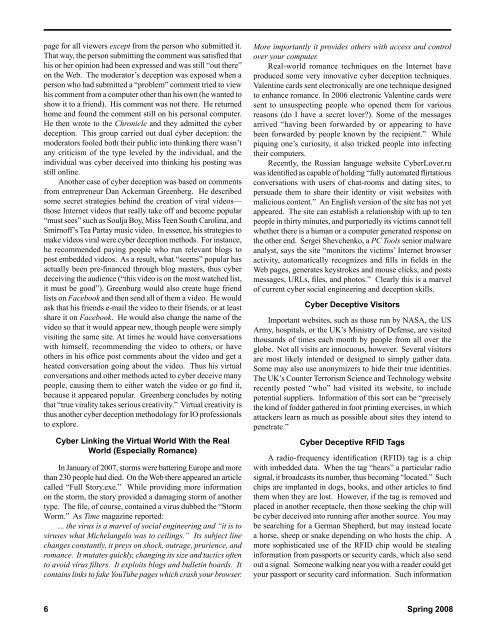Download - IO Sphere
Download - IO Sphere
Download - IO Sphere
Create successful ePaper yourself
Turn your PDF publications into a flip-book with our unique Google optimized e-Paper software.
page for all viewers except from the person who submitted it.<br />
That way, the person submitting the comment was satisfied that<br />
his or her opinion had been expressed and was still “out there”<br />
on the Web. The moderator’s deception was exposed when a<br />
person who had submitted a “problem” comment tried to view<br />
his comment from a computer other than his own (he wanted to<br />
show it to a friend). His comment was not there. He returned<br />
home and found the comment still on his personal computer.<br />
He then wrote to the Chronicle and they admitted the cyber<br />
deception. This group carried out dual cyber deception: the<br />
moderators fooled both their public into thinking there wasn’t<br />
any criticism of the type leveled by the individual, and the<br />
individual was cyber deceived into thinking his posting was<br />
still online.<br />
Another case of cyber deception was based on comments<br />
from entrepreneur Dan Ackerman Greenberg. He described<br />
some secret strategies behind the creation of viral videos—<br />
those Internet videos that really take off and become popular<br />
“must sees” such as Soulja Boy, Miss Teen South Carolina, and<br />
Smirnoff’s Tea Partay music video. In essence, his strategies to<br />
make videos viral were cyber deception methods. For instance,<br />
he recommended paying people who run relevant blogs to<br />
post embedded videos. As a result, what “seems” popular has<br />
actually been pre-financed through blog masters, thus cyber<br />
deceiving the audience (“this video is on the most watched list,<br />
it must be good”). Greenburg would also create huge friend<br />
lists on Facebook and then send all of them a video. He would<br />
ask that his friends e-mail the video to their friends, or at least<br />
share it on Facebook. He would also change the name of the<br />
video so that it would appear new, though people were simply<br />
visiting the same site. At times he would have conversations<br />
with himself, recommending the video to others, or have<br />
others in his office post comments about the video and get a<br />
heated conversation going about the video. Thus his virtual<br />
conversations and other methods acted to cyber deceive many<br />
people, causing them to either watch the video or go find it,<br />
because it appeared popular. Greenberg concludes by noting<br />
that “true virality takes serious creativity.” Virtual creativity is<br />
thus another cyber deception methodology for <strong>IO</strong> professionals<br />
to explore.<br />
Cyber Linking the Virtual World With the Real<br />
World (Especially Romance)<br />
In January of 2007, storms were battering Europe and more<br />
than 230 people had died. On the Web there appeared an article<br />
called “Full Story.exe.” While providing more information<br />
on the storm, the story provided a damaging storm of another<br />
type. The file, of course, contained a virus dubbed the “Storm<br />
Worm.” As Time magazine reported:<br />
... the virus is a marvel of social engineering and “it is to<br />
viruses what Michelangelo was to ceilings.” Its subject line<br />
changes constantly, it preys on shock, outrage, prurience, and<br />
romance. It mutates quickly, changing its size and tactics often<br />
to avoid virus filters. It exploits blogs and bulletin boards. It<br />
contains links to fake YouTube pages which crash your browser.<br />
More importantly it provides others with access and control<br />
over your computer.<br />
Real-world romance techniques on the Internet have<br />
produced some very innovative cyber deception techniques.<br />
Valentine cards sent electronically are one technique designed<br />
to enhance romance. In 2006 electronic Valentine cards were<br />
sent to unsuspecting people who opened them for various<br />
reasons (do I have a secret lover?). Some of the messages<br />
arrived “having been forwarded by or appearing to have<br />
been forwarded by people known by the recipient.” While<br />
piquing one’s curiosity, it also tricked people into infecting<br />
their computers.<br />
Recently, the Russian language website CyberLover.ru<br />
was identified as capable of holding “fully automated flirtatious<br />
conversations with users of chat-rooms and dating sites, to<br />
persuade them to share their identity or visit websites with<br />
malicious content.” An English version of the site has not yet<br />
appeared. The site can establish a relationship with up to ten<br />
people in thirty minutes, and purportedly its victims cannot tell<br />
whether there is a human or a computer generated response on<br />
the other end. Sergei Shevchenko, a PC Tools senior malware<br />
analyst, says the site “monitors the victims’ Internet browser<br />
activity, automatically recognizes and fills in fields in the<br />
Web pages, generates keystrokes and mouse clicks, and posts<br />
messages, URLs, files, and photos.” Clearly this is a marvel<br />
of current cyber social engineering and deception skills.<br />
Cyber Deceptive Visitors<br />
Important websites, such as those run by NASA, the US<br />
Army, hospitals, or the UK’s Ministry of Defense, are visited<br />
thousands of times each month by people from all over the<br />
globe. Not all visits are innocuous, however. Several visitors<br />
are most likely intended or designed to simply gather data.<br />
Some may also use anonymizers to hide their true identities.<br />
The UK’s Counter Terrorism Science and Technology website<br />
recently posted “who” had visited its website, to include<br />
potential suppliers. Information of this sort can be “precisely<br />
the kind of fodder gathered in foot printing exercises, in which<br />
attackers learn as much as possible about sites they intend to<br />
penetrate.”<br />
Cyber Deceptive RFID Tags<br />
A radio-frequency identification (RFID) tag is a chip<br />
with imbedded data. When the tag “hears” a particular radio<br />
signal, it broadcasts its number, thus becoming “located.” Such<br />
chips are implanted in dogs, books, and other articles to find<br />
them when they are lost. However, if the tag is removed and<br />
placed in another receptacle, then those seeking the chip will<br />
be cyber deceived into running after another source. You may<br />
be searching for a German Shepherd, but may instead locate<br />
a horse, sheep or snake depending on who hosts the chip. A<br />
more sophisticated use of the RFID chip would be stealing<br />
information from passports or security cards, which also send<br />
out a signal. Someone walking near you with a reader could get<br />
your passport or security card information. Such information<br />
6 Spring 2008




